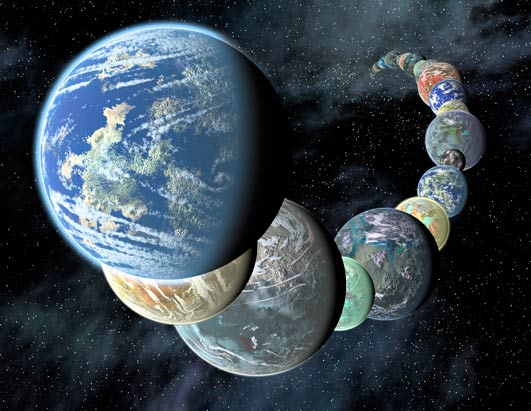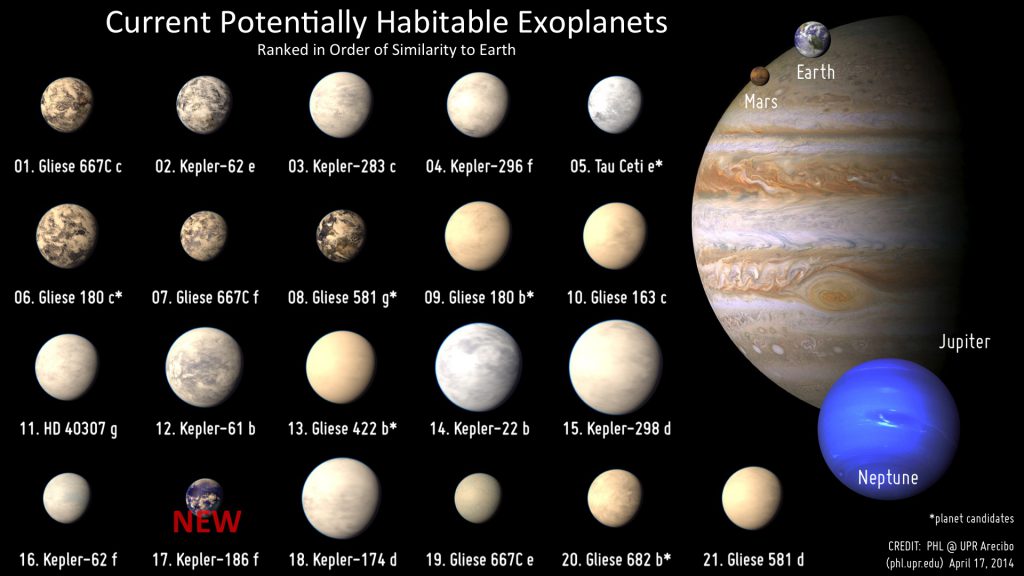An exoplanet (or extrasolar planet) is a planet which orbits a star other than the Sun, i.e. which belongs to a planetary system other than our solar system (the “exo” prefix means “outside” in Greek). The frequency of extrasolar planets is one of the parameters in the Drake equation, which attempts to estimate the probability of communications with extraterrestrial intelligence.
Although searching for alien worlds dates back to ancient times the techniques needed to detect them have only recently been developed with the first exoplanet being discovered in 1992. The discovery of Gliese 581 g, a Goldilocks planet only 20 light-years from Earth, has further called the Rare Earth hypothesis into question. With such proximity to Earth, astrologists now estimate that the likelihood of finding an Earth-like planet in any given system in our galaxy is 10-20%.
Over 570 exoplanets are known as of late 2011 and more are continually discovered. Alan Boss of the Carnegie Institution of Science estimates there may be 100 billion terrestrial planets in our Milky Way Galaxy alone. Boss believes many could have simple lifeforms and there could be thousands of civilizations in our galaxy.

Methods of detection
Exoplanets are very difficult to detect because they don’t emit any light of their own and are completely obscured by their extremely bright parent stars – normal telescope observation techniques cannot be used. In order to find exoplanets we use a variety of techniques to detect the effect they have on their stellar system.
There are two main methods of detecting extrasolar planets, which are too faint to be detected by present conventional optical means. The first involves measuring the displacement in the parent star’s spectral lines due to the Doppler effect induced by the planet orbiting the star and moving it through mutual gravitation. The second involves catching the planet as it passes in front of the star’s tiny disk which will cause the light of the star to “dip” in a distinctive way, and do so periodically as the planet completes multiple orbits. The second method is theoretically more sensitive, but is newer and has scored fewer successes. It also depends on the plane of the planet’s orbit being aligned with the line of sight between the star and the Earth. As a result, any number of stars with planets that are not so aligned will be missed.
Astronomers particularly want to observe the visible and infrared spectra of distant terrestrial planets to learn about their atmospheres. Particular gases leave signatures in a planet’s spectrum, like fingerprints or DNA markers. By spotting those fingerprints, researchers can learn about an atmosphere’s composition and even deduce the presence of clouds.
If an extrasolar planet is found with a spectrum similar to one of our models, we potentially could characterize that planet’s geological state, its habitability, and the degree to which life has thrived on it.
History of exoplanets search
Extrasolar planets were discovered during the 1990s as a result of improved telescope technology, such as CCD and computer-based image processing along with the Hubble Space Telescope. Such advances allowed for more accurate measurements of stellar motion, allowing astronomers to detect planets, not visually (the luminosity of a planet being too low for such detection), but by measuring gravitational influences upon stars. In addition, extrasolar planets can be detected by measuring the variance in a star’s apparent luminosity, as a planet passes in front of it.
The Polish astronomer Aleksander Wolszczan claimed to have found the first extrasolar planets in 1993, orbiting the pulsar PSR 1257+12. Subsequent investigation has determined that these objects are not “true” planets in that they are technically “sub-brown dwarf masses orbiting an object that is or once was a star”; it is believed that they are unusual remnants of the supernova that produced the pulsar, and did not form as conventional planets do.
The first “true” extrasolar planet was announced on October 6, 1995 by Michael Mayor and Didier Queloz; the primary star was 51 Pegasi. Since then dozens of planets have been detected, many by a team led by Geoffrey Marcy at the University of California’s Lick and Keck Observatories. The first system to have more than one planet detected was Upsilon Andromedae. The majority of the detected planets have highly elliptical orbits.
On November 27, 2001, astronomers using the Hubble Space Telescope announced that they had detected the atmosphere of the planet orbiting HD 209458, from its absorption of light when passing in front of its star. Also during that year, a star was located which had the remnants of one or more planets within the stellar atmosphere – apparently the planet was mostly vaporized.
In 2002 a group of Polish astronomers (Professors Andrzej Udalski and Marcin Kubiak and Dr. Michal Szymanski from Warsaw, and Polish-American Professor Bogdan Paczynski from Princeton) during project OGLE (the Optical Gravitational Lensing Experiment) worked out a method of easily finding extrasolar planets, based on a photometrical method. During one month they claimed to find 46 objects, many of which could be planets.

On July 10, 2003, using information obtained from the Hubble Space Telescope, scientists discovered the oldest extrasolar planet yet. Dubbed Methuselah after the biblical figure, the planet is about 5,600 light years from Earth, has a mass twice that of Jupiter, and is estimated to be 13 billion years old. It is located in the globular star cluster M4, approximately 7200 light years from Earth in the constellation Scorpius.
On April 24, 2007, scientists at the European Southern Observatory in La Silla, Chile said they had found the first Earth-like planet. The planet, known as Gliese 581 c, orbits within the habitable zone of its star Gliese 581, a red dwarf star which is 20.5 light years (194 trillion km) from the Earth.
The Kepler spacecraft is the 10th NASA Discovery mission launched in March 2009 which was designed to search for exoplanets by measuring almost continuously the brightness of 156,453 stars in a small 12 degree diameter patch of the sky. The 0.95m-telescope is able to detect attenuation of the host star located in the Cygnus, Lyra, Draco constellations which could be due to the transit of an exoplanet passing between its star and us. A transit gives direct estimate on the size of the exoplanet and its orbit.
For the first time, astronomers are able to define families of exoplanets arbitrary classified per size which are:
– 68 Earth-size exoplanets with a radius (Rp) of less than 1.25 Earth radius (Re)
– 288 super-Earth size exoplanets with 1.25 x Re < Rp = 2.0 x Re
– 662 Neptune-size exoplanets with 2.0 x Re < Rp = 6.0 x Re
– 165 Jupiter-size exoplanets with 6.0 x Re < Rp = 15 x Re
– 19 very-large-size with 15.0 x Re < Rp = 22 x Re
The next generation of space-based missions such as and ESA’s Darwin will be able to directly study nearby Earth-sized worlds. The space missions include NASA’s Space Interferometry Mission, NASA’s Terrestrial Planet Finder (TPF) and Kepler , ESA’s Darwin, Gaia and (Eddington) and France’s COROT.
From exo to habitable planets
Planets can be divided into two groups, the telluric planets and the gas giant (or “Jovian”) planets. The telluric planets are spherical bodies with a crust of rock, and the gas giant planets are spheres composed of gas and ice (Jupiter, Saturn, Uranus and Neptune). A large number of the exoplanets found so far are known as ‘Hot Jupiters’ – gas giant planets similar in size to Jupiter that orbit extremely close to their parent star. They are easy to detect because of their large size and short orbital period. However, they are unsuitable for hosting life. It is thought the most likely location for life to exist is on small ‘Earth-like’ rocky planets within a region of the stellar system known as the ‘Habitable zone’ where temperatures are suitable for liquid water to form.
Most of the planets found are of relatively high mass (at least 40 times that of the Earth); however, a couple seem to be approximately the size of the Earth. This reflects the current telescope technology, which is not able to detect smaller planets. The mass distribution should not be taken as a reference for a general estimate, since it is likely that many more planets with smaller mass, even in nearby solar systems, are still undetected.
One question raised by the detection of extrasolar planets is why so many of the detected planets are gas giants which, in comparison to Earth’s solar system, are unexpectedly close to the orbited star. For example, Tau Boötis has a planet 4.1 times Jupiter’s mass, which is less than a quarter of an astronomical unit (AU) from the orbited star; HD 114762 has a planet 11 times Jupiter’s mass, which is less than half an AU from the orbited star. One possible answer to these unexpected planetary orbits is that since astrometrics detects the extrasolar planets due to their gravitational influences and partially-ecliptic interference, perhaps current technology only permits the detection of systems where a large planet is close to the orbited star, rather than such systems being the norm.
Astronomers also search for extrasolar planets that they believe would be conducive to life, such as Gliese 581 c, Gliese 581 g, Gliese 581 d and OGLE-2005-BLG-390Lb, which have been found to have Earth-like qualities. New refinements in exoplanet detection methods, and use of existing methods from space, (such as the Kepler Mission, launched in 2009) are expected to detect and characterize terrestrial-size planets, and determine if they are within the habitable zones of their stars. Using methods like the Drake equation with this data would therefore has a direct consequence over the expectations behind the Fermi paradox itself.








